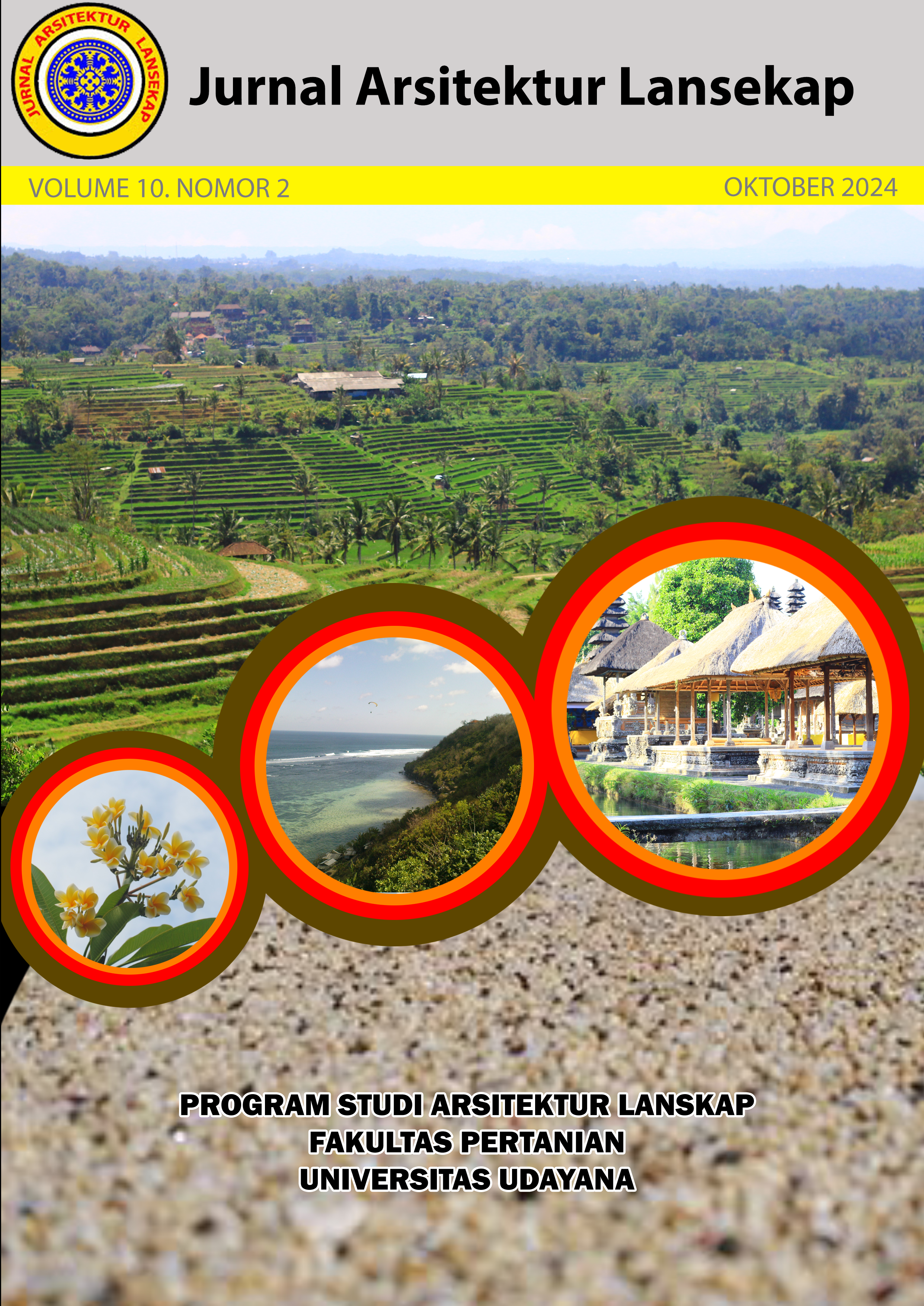Perancangan Taman Vertikal Pada Dinding Underpass Simpang Tugu I Gusti Ngurah Rai
Abstract
The increase in physical development in urban areas is in line with the increase in air pollution. The process of burning gas from the exhaust can pollute the air up to about 60% of other air pollutant factors. Air pollution that is commonly found in urban areas is Nitrogen Oxides (NOx). Nitrogen oxides (NOx) are chemical compounds of oxygen and nitrogen that are formed from combustion at high temperatures, especially the combustion of fuels that are responsible for the smog and brown clouds that cover large cities and produce poor air quality and cause serious health effects serious in humans. One way to overcome the problem of air pollution in urban areas with narrow land, is to plant a vertical garden model of road plants. Vertical garden is a landscaping business by utilizing land as much as possible, by utilizing the potential of vertical walls in the area so that the number of plants per unit area is more. The purpose of writing this paper is to see the potential application of the concept of vertical gardens on the underpass wall by optimizing the potential and overcoming obstacles in the path of the Simpang Tugu I Gusti Ngurah Rai underpass. The research method used is a survey method with data collection techniques through observation, interviews, and literature studies. The results showed that the underpass wall can be installed with a vertical garden with a structural truss method that is attached to the underpass wall and using a drip irrigation system controlled by a timer for watering and fertilizing. And the results of the vegetation design using shrubs that are able to neutralize nitrogen oxides (NOx), namely Es lilin hijau (Chlorophytum bichetii), Kriminil hijau (Alternanthera ficoida) and Taiwan beauty (Cuphea hyssophylla). For the design of the vertical garden planting pattern, it will follow the stylized form of the Mas-Mas Keketusan Ornament.
Downloads
References
2018.
BMKG. 2019. Pelayanan Jasa Informasi Klimatologi.
BPS Kabupaten Badung. 2019. Kecamatan Kuta Utara Dalam Angka (B. K. Badung (ed.)). BPS Kabupaten
Badung.
Fajarini, U. 2014. Peranan Kearifan Lokal Dalam Pendidikan Karakter. Sosio Didaktika: Social Science
Education Journal 1(2):123–124.
Gelebet, I. N., Meganada, I. W., Yasanegara, I. M., Sutriya, I. M., & Surata, I. N. 2002. Arsitektur Tradisional
Daerah Bali. Badan Pengembangan Kebudayaan dan Pariwisata Bali.
Hastuti, K., Hidayat, E. Y., & Rahmawan, E. 2013. Purwarupa Tangible Cultural Heritage Documentation
Berbasis Database Multimedia. Jurnal Techno.Com 12(4):188-197.
Namoua, F., Manengkey, H. W. K., & Rampengan, R. M. 2017. Morfometri Lereng Gisik Di Pantai Tumpaan
Kecamatan Tumpaan Kabupaten Minahasa Selatan. Jurnal Pesisir Dan Laut Tropis 1(2):14-19.
Noviasi, N. K. P., Waleleng, G. J., & Tampi, J. R. (2015). Fungsi Banjar Adat Dalam Kehidupan Masyarakat
Etnis Bali Di Desa Werdhi Agung, Kecamatan Dumoga Tengah, Kabupaten Bolang Mongondow
Provinsi Sulawesi Utara. Jurnal Acta Diurna IV(3):1-10.
Puspa, I. A. T., & Saitya, I. B. S. (2019). Ngaben sebagai Daya Tarik Pariwisata. Jurnal Ilmiah Pariwisata
Agama Dan Budaya 4(1):37-45.
Sawitri, Y., Hidayat, W., & Nurseto, S. (2013). Pengaruh Kualitas Produk, Promosi, Faktor Sosial Dan Faktor
Psikologi Terhadap Keputusan Pembelian Sepedamotormatic Yamahamio (Studi Pada Yamaha
Agungmotor Semarang). Journal of Social and Politic 2(2):1-9.
Sudjana. (2002). Metode Statistika. Tarsito.
Sugianthara, A. A. G., Sarwadana, S. M., Lila, I. K. A., & Sudarsana, A. A. G. D. (2017). Identifikasi dan
Morfometri Taman Setra di Kecamatan Ubud. Jurnal Arsitektur Lanskap 3(1):87–88.
An author who publishes in the Jurnal Arsitektur Lansekap (JAL) agrees to the following terms:
- Author retains the copyright and grants the journal the right of first publication of the work simultaneously licensed under the Creative Commons Attribution-ShareAlike 4.0 License that allows others to share the work with an acknowledgement of the work's authorship and initial publication in this journal
- Author is able to enter into separate, additional contractual arrangements for the non-exclusive distribution of the journal's published version of the work (e.g., post it to an institutional repository or publish it in a book) with the acknowledgement of its initial publication in this journal.
- Author is permitted and encouraged to post his/her work online (e.g., in institutional repositories or on their website) prior to and during the submission process, as it can lead to productive exchanges, as well as earlier and greater citation of the published work (See The Effect of Open Access).
Read more about the Creative Commons Attribution-ShareAlike 4.0 Licence here: https://creativecommons.org/licenses/by-sa/4.0/.







